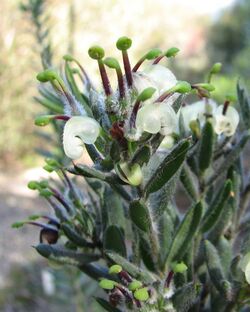Biology:Grevillea jephcottii
| Pine Mountain grevillea | |
|---|---|

| |
| In Maranoa Gardens | |
| Scientific classification | |
| Kingdom: | Plantae |
| Clade: | Tracheophytes |
| Clade: | Angiosperms |
| Clade: | Eudicots |
| Order: | Proteales |
| Family: | Proteaceae |
| Genus: | Grevillea |
| Species: | G. jephcottii
|
| Binomial name | |
| Grevillea jephcottii J.H.Willis[1]
| |
Grevillea jephcottii, commonly known as Pine Mountain grevillea, green grevillea or Jephcotts grevillea[2] is a species of flowering plant in the family Proteaceae and is endemic to a restricted area of Victoria. It is a low dense, to tall spindly shrub with narrowly oblong to narrowly elliptic leaves, and clusters of pale lemon or greenish flowers with a purplish style.
Description
Grevillea jephcottii is a low, dense, to erect, spindly shrub that typically grows to a height of 1–3 m (3 ft 3 in–9 ft 10 in). Its leaves are narrowly oblong to narrowly elliptic, 10–35 mm (0.39–1.38 in) long and 1.5–6 mm (0.059–0.236 in) wide and glabrous when mature. The flowers are usually arranged on the ends of branches in groups of three to eight on a rachis 2–3 mm (0.079–0.118 in) long and are pale lemon or greenish, turning black as they age, the pistil 9.0–19.5 mm (0.35–0.77 in) long and the style purplish with white hairs. Flowering occurs from July to November and the fruit is a narrowly oval follicle 10–15 mm (0.39–0.59 in) long.[2][3][4][5]
Taxonomy
Grevillea jephcottii was first formally described in 1967 by James Hamlyn Willis in the journal Muelleria from specimens he collected on the south-west slopes of Pine Mountain in 1964.[5][6] The specific epithet (jephcottii), honours the Jephcott family from Ournie, who were the first to collect specimens from the area. Sydney Wheeler Jephcott discovered the plant at the age of 14 in 1878.[5]
Distribution and habitat
Pine Mountain grevillea occurs in a restricted area of north-eastern Victoria between Walwa and Corryong at altitudes ranging between 550 and 650 m (1,800 and 2,130 ft) where it grows in rocky places in dry forest.
Conservation status
The species is listed as "endangered" in Victoria under the Flora and Fauna Guarantee Act 1988[7] and is listed as "rare in Victoria" on the Department of Sustainability and Environment's Advisory List of Rare Or Threatened Plants In Victoria.[8]
References
- ↑ "Grevillea jephcottii". Australian Plant Census. https://biodiversity.org.au/nsl/services/apc-format/display/85066.
- ↑ 2.0 2.1 Hitchcock, James (2005). "Grevillea jephcottii". Growing Australian Plants. http://www.anbg.gov.au/gnp/interns-2005/grevillea-jephcottii.html.
- ↑ "Grevillea jephcottii". Australian Biological Resources Study, Department of Agriculture, Water and the Environment: Canberra. https://profiles.ala.org.au/opus/foa/profile/Grevillea%20jephcottii.
- ↑ Olde, Peter M.; Marriott, Neil R.. "Grevillea jephcottii". Royal Botanic Gardens Victoria. https://vicflora.rbg.vic.gov.au/flora/taxon/4eb1dfb3-ac36-4cfe-8007-75b8fee9fbcb.
- ↑ 5.0 5.1 5.2 Willis, James H. (1967). "Systematic Notes on the Indigenous Australian Flora.". Muelleria 1 (3): 117–118. https://www.biodiversitylibrary.org/item/199349#page/5/mode/1up. Retrieved 31 May 2022.
- ↑ "Grevillea jephcottii". APNI. https://id.biodiversity.org.au/instance/apni/503605.
- ↑ "Grevillea jephcottii". Royal Botanic Gardens Victoria. https://vicflora.rbg.vic.gov.au/flora/taxon/4eb1dfb3-ac36-4cfe-8007-75b8fee9fbcb.
- ↑ "Advisory list of rare or threatened plants in Victoria - 2014". State of Victoria Department of Environment and Primary Industries. https://www.environment.vic.gov.au/__data/assets/pdf_file/0021/50448/Advisory-List-of-Rare-or-Threatened-Plants-in-Victoria-2014.pdf.
External links
Wikidata ☰ Q5607953 entry
 |

